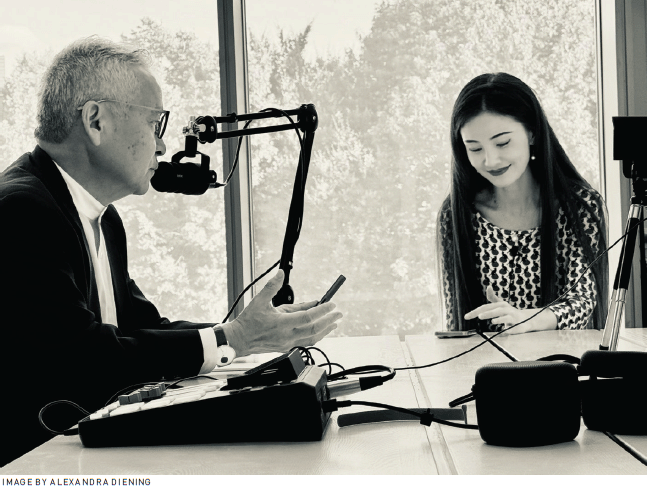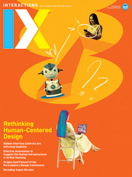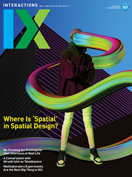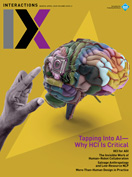Authors:
Jie Li
I want to always remember you. I want to always be remembered by you.— Hiroshi Ishii
One day, after bedtime reading my daughter said, "Mama, I want to hear Grandpa talking." I was initially shocked, as my father had passed away a few years ago. I asked why she wanted to hear Grandpa's voice. My daughter replied, "I miss him, and I find his dialect really funny. So, I want to hear him."
That's when I remembered I still have many voice messages from my father saved on WeChat. I played some of them for her. Instead of feeling sad, we actually started laughing about his dialect. Both of us deeply miss him, but this experience turned into a heartwarming and joyful moment.
Later, I shared this story with Hiroshi Ishii, a professor at MIT, a visionary in HCI, and the creator of the concept of TeleAbsence (https://bit.ly/3Yh8gQ5). His response was thoughtful: "This is precisely why absence is sometimes the highest form of presence. It's the spaces in between, the gaps in memory, that let us feel profound."
Ishii continued: "There's a Portuguese word, saudade, that perfectly encapsulates this idea. It's often described as the 'desire for the beloved thing made painful by its absence.' It's that bittersweet longing we feel when we deeply miss someone or something. Saudade resonates universally—it's not just about loss but about cherishing the emptiness left behind. This is what TeleAbsence seeks to embrace. Rather than erasing absence or filling it completely, it preserves its authenticity and honors the emotional connections absence evokes."
Intrigued, I asked how TeleAbsence embraces these gaps while other technologies seem to focus on filling them completely, like re-creating the deceased.
 | Hiroshi Ishii and the author discussed TeleAbsence at the MIT Media Lab. |
Ishii leaned forward and smiled. "Let me tell you a story of 'presence of absence.' Imagine a shadow cast on the wall—a silhouette left behind by a loved one who is no longer there. That shadow doesn't pretend to be the person, yet it carries their presence. This is the foundation of TeleAbsence [1,2]. It's not about re-creating the deceased through AI, but about preserving the authenticity of their absence."
 Beyond Mourning: Memory Traces as a Gentle Approach to Connection
Beyond Mourning: Memory Traces as a Gentle Approach to Connection
Ishii and I discussed how modern technology increasingly pushes the boundaries of re-creating human presence. Eternal You, a documentary directed by Hans Block and Moritz Riesewieck, portrays AI systems that simulate deceased individuals through lifelike avatars, voice modulation, and even personalized conversations [3]. Similarly, an episode of the dystopian anthology series Black Mirror, "Be Right Back," explores the consequences of creating AI-powered replicas of loved ones. These technologies often aim to replace the void left by the deceased, but they also blur the line between memory and reality.
In contrast, Ishii's concept of TeleAbsence focuses on memory traces—subtle, poetic reminders of the past. "It's about tangible and intangible elements that carry emotional weight—like your father's voice messages," he explained. "They don't try to replace him; instead, they allow your daughter to connect with him in her own way."
I nodded, reflecting on how powerful it had been to hear my father's voice without any attempt at re-creating his presence. TeleAbsence isn't about building an illusion, then?
"Exactly," Ishii replied. "It's about designing for absence, not presence. It's why I admire projects like the Wind Phone in Japan. It's a disconnected rotary phone that allows people to 'call' loved ones they've lost [4]. It's not about creating a conversation but offering a space for connection and illusory communication."
Ishii further elaborated that memory traces aren't limited to relationships with others; they also extend to our connection with ourselves. "TeleAbsence helps us reconnect with the past versions of who we were—our younger selves," he explained. "A journal entry, a childhood photograph, or a recording of your teenage voice can act as meaningful memory traces. These aren't about indulging in nostalgia but embracing the journey and growth that brought you to the present. By cherishing these fragments of the past, we foster a deeper understanding of our identity and evolution." In this light, TeleAbsence offers more than just a bridge to lost relationships—it becomes a means of self-reflection and connection, intertwining the narratives of who we've loved and who we've been and embracing both the gaps in our relationships and the spaces within ourselves.
 Designing for Absence: A Conversation on Principles
Designing for Absence: A Conversation on Principles
I asked Ishii how one can design something like TeleAbsence, which seems so abstract yet deeply personal. He outlined five principles.
Presence of absence. Ishii referenced the Hiroshima shadow memorial to illustrate this concept—a haunting yet poetic representation of absence. In Hiroshima, the preserved shadow on the stone serves as a reminder of the person who perished during the atomic bombing [5]. This shadow doesn't attempt to re-create the individual but symbolizes their existence and the weight of their absence.
In TeleAbsence, this principle can be applied through digital or physical representations that evoke a person without attempting full re-creation. Imagine a dining chair that faintly warms when you sit in it, as if echoing the presence of a loved one who once used it. Or a photograph that subtly alters its color or brightness based on the time of day the photo was taken. Such designs provide a tangible connection to the past while respecting the authenticity of loss and memory.
Illusory communication. Illusory communication focuses on creating moments of connection that evoke shared experiences without falsifying interaction. For instance, a device could replay ambient sounds tied to significant memories—a gentle wave crashing on the shore from a family vacation, birds chirping from a quiet morning walk, or the faint hum of a kitchen alive with conversation during holiday gatherings.
Unlike artificial re-creations of voices or conversations, this method keeps the experience subtle and indirect, allowing the mind to fill in the emotional context. A more advanced example might include a wearable device that gently vibrates in sync with the rhythm of a loved one's recorded heartbeat, offering a soothing, physical reminder of their presence. Another example could involve rediscovering letters or messages you wrote to your future self, enhanced with a mixed-reality interface that projects visuals of what you described in those letters. These sensory cues foster reflection and comfort without crossing into artificial simulation.
Materiality of memory. Objects have always served as anchors for memory, and TeleAbsence builds on this human instinct. Ishii spoke of jewelry or books as examples of material memory, but this idea can extend much further. Imagine a digital locket that stores voice recordings, photos, or even handwritten notes, which you can access by simply touching them.
This principle also embraces tactile experiences. A scarf that emits a familiar scent—such as a favorite perfume or the smell of home—can evoke moments shared with someone who's no longer there. Imagine revisiting your younger self by wearing a glove embedded with tactile sensors that replay the sensation of learning something new, like playing an instrument or molding clay during an art class. This emphasizes the idea that memory lives not just in digital archives but also in objects we can touch, hold, and cherish.
Traces of reflection. Reflection often arises from subtle remnants of a person's life, and this principle leverages those fragments to inspire introspection. Think of handwritten notes, doodles on a calendar, or even a grocery list left behind. These small, seemingly mundane items become deeply personal when preserved. For example, a digital photo album might incorporate scanned pages of a loved one's handwritten recipes or notes in margins of books they read.
Another example could be a desk organizer that emits faint projections of a person's handwriting on its surface, allowing you to revisit their thoughts without overwhelming your space. Alternatively, an interactive map could display the places you frequented at different stages of your life, accompanied by notes or reflections on why they mattered to you. By curating these traces in creative ways, TeleAbsence encourages individuals to contemplate and celebrate the idiosyncrasies of both those they've lost and their younger selves.
Remote time. Remote time focuses on re-creating atmospheres or environments associated with someone. Ishii mentioned the acoustics of Notre-Dame before the fire as an example, but this idea can be expanded in many directions. Imagine a VR headset that allows you to "visit" a home you grew up in, complete with accurate lighting, sounds, and textures.
Similarly, an immersive sound system could replicate the ambience of a place shared with a loved one, such as a café where important conversations occurred or a park where you took walks together. The goal isn't to transport you back in time but to let you experience the emotional tone of those environments. It's about reengaging with spaces that carry meaning, creating a bridge between memory and presence.
I asked Ishii why we should focus on the gaps rather than attempting a full recreation, as some AI systems do.
"Re-creation often becomes a betrayal of memory," he replied solemnly. "It risks erasing the imperfections and authenticity that make memories meaningful. By embracing absence, we allow people to heal and reflect without becoming trapped in an illusion."
 | Telepresence versus TeleAbsence. |
 Ethical Considerations: How Far Is Too Far?
Ethical Considerations: How Far Is Too Far?
Our discussion inevitably turned to ethics. I asked Ishii if he thought there's a risk that TeleAbsence could be misused, like turning memory traces into commercialized products.
He paused before answering. "Every technology carries risks," he said. "It depends on the intention behind its use. TeleAbsence must never commodify grief or exploit people's vulnerabilities. Instead, it should serve as a tool for healing, designed with care and empathy."
We explored the ethical boundaries of using technology to navigate loss. Ishii highlighted how a lack of regulation or ethical oversight could blur the lines between helpful tools and harmful exploitation. "If left unchecked, these tools could easily cross into manipulative territory. Imagine a future where a company tempts you to pay for 'premium' memories of a loved one or upgrades to make those memories more 'lifelike.' It's not just unethical; it's dehumanizing," he explained.
We also discussed the psychological implications. Studies show that overly immersive interactions with digital recreations of loved ones can complicate the grieving process [6]. "It's like being stuck in a loop," Ishii said. "Instead of moving forward, people can become fixated on what they've lost."
Ishii emphasized that TeleAbsence must strike a balance—offering solace without fostering dependency. "The goal is to provide a gentle nudge toward reflection and acceptance, not to trap someone in an endless replay of the past," he said. This balance, however, requires thoughtful design and a commitment to ethical principles.
Drawing from both Eternal You and Black Mirror, I asked Ishii if he thinks society is ready for technologies like TeleAbsence, or if we're still grappling with what it means to mourn in a digital age.
"Society often adopts technology faster than it can understand its impact," Ishii responded. "Look at social media—it has reshaped how we communicate but also isolated us in unexpected ways. TeleAbsence requires careful integration. It's not about replacing grief but complementing it with tools that respect human emotions."
After my conversation with Ishii, I reflected on how his ideas intersected with my own experiences. Playing my father's voice for my daughter was a small act of connection—an embodiment of TeleAbsence, even if I didn't realize it at the time. It reminded me that memory isn't just about holding on; it's about finding ways to let go with grace. More importantly, the ethical considerations of TeleAbsence are as crucial as its technical innovations. Without a framework grounded in empathy, respect, and a deep understanding of human emotion, even the most well-intentioned technologies could cause unintended harm.
TeleAbsence offers a way to preserve and honor those we've lost, and to reconnect with the traces of our younger selves, without undermining the authenticity of grief or self-reflection. In a world where AI promises eternal digital life, Hiroshi Ishii's vision is a vital reminder: The essence of memory lies not in perfection but in imperfection—the gaps, the absences, and the human need to fill them with love, meaning, and a deeper understanding of our own evolving identities.
1. Ishii, H. TeleAbsence: Recalling remote time. XPANSE 2024 keynote speech, Abu Dhabi, Nov. 21, 2024; https://tangible.media.mit.edu/event/193/
2. Ishii, H. et al. TeleAbsence: A vision of past and afterlife telepresence. PRESENCE: Virtual and Augmented Reality 34 (2025), MIT Press, 65–95; https://dspace.mit.edu/handle/1721.1/158451
3. Block, H. and Riesewieck, M. Eternal You. Beetz Brothers Film Production, 2024.
4. Hester, J. The phone booth for Japanese mourners. Bloomberg. Jan. 10, 2017; https://www.bloomberg.com/news/articles/2017-01-10/japan-s-wind-phone-is-a-site-to-mediate-on-life-and-loss
5. Serena, K. See the eerie shadows of Hiroshima that were burned into the ground by the atomic bomb. All That's Interesting. Jan. 19, 2023; https://allthatsinteresting.com/hiroshima-shadows
6. Pataranutaporn, P. et al. Living memories: AI-generated characters as digital mementos. Proc. of the 28th International Conference on Intelligent User Interfaces. ACM, 2023, 889–901.
Jie Li is an HCI researcher with a background in industrial design engineering. Her research focuses on developing evaluation metrics for immersive experiences. She is chief scientific officer at Human-AI Symbiosis Alliance (HAISA) as well as a creative cake designer and the owner of Cake Researcher, a boutique café. [email protected]
Copyright 2025 held by owner/author
The Digital Library is published by the Association for Computing Machinery. Copyright © 2025 ACM, Inc.






Post Comment
No Comments Found